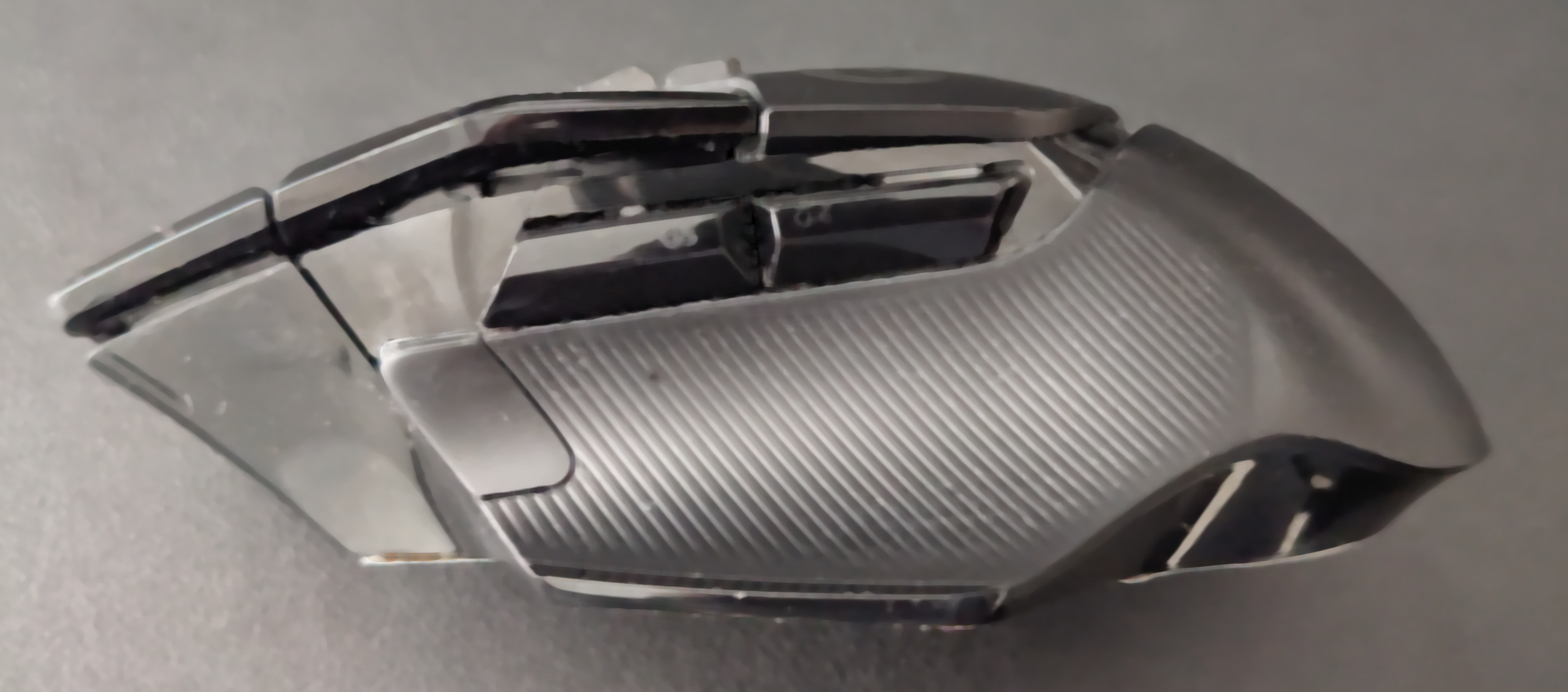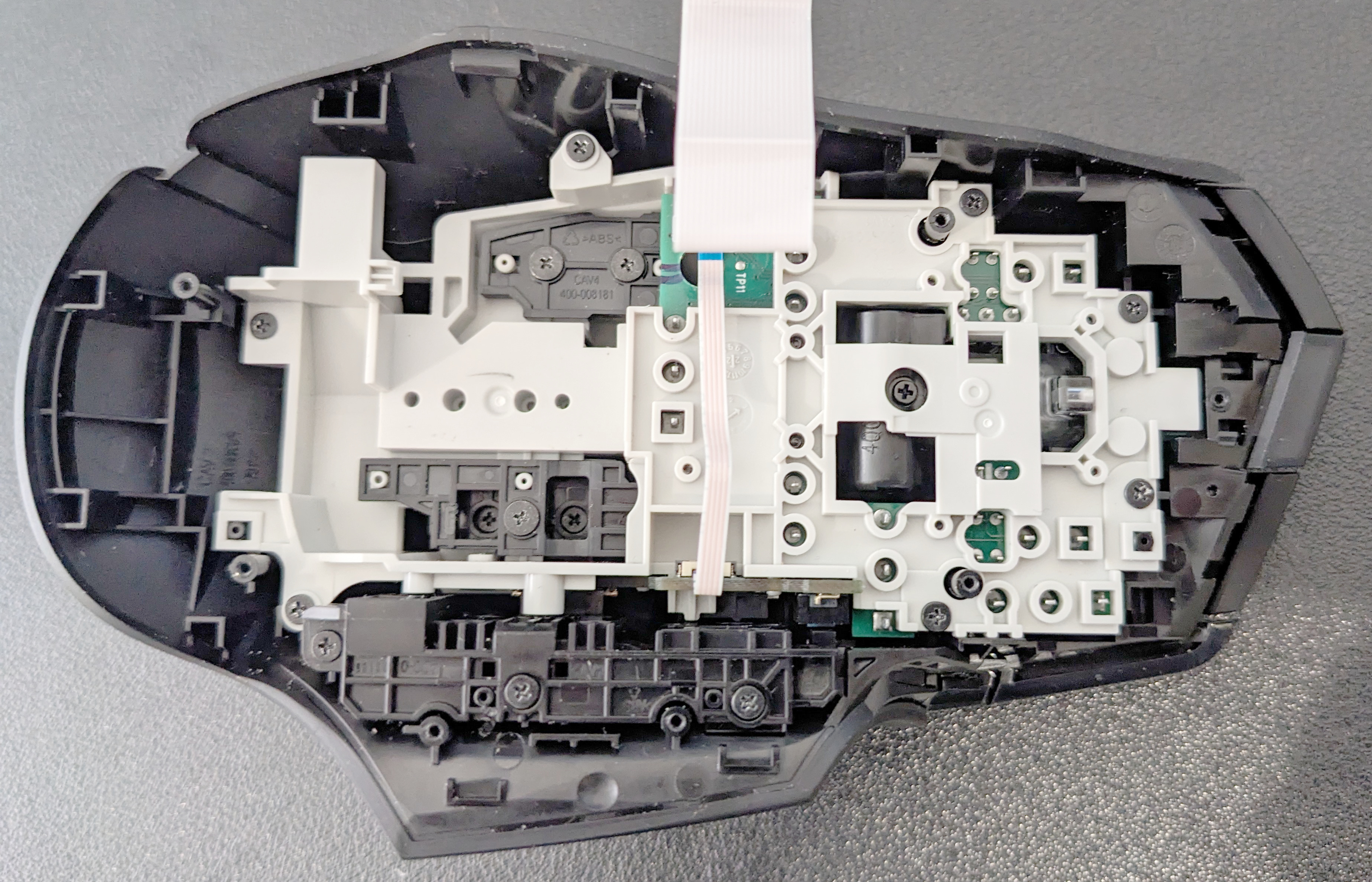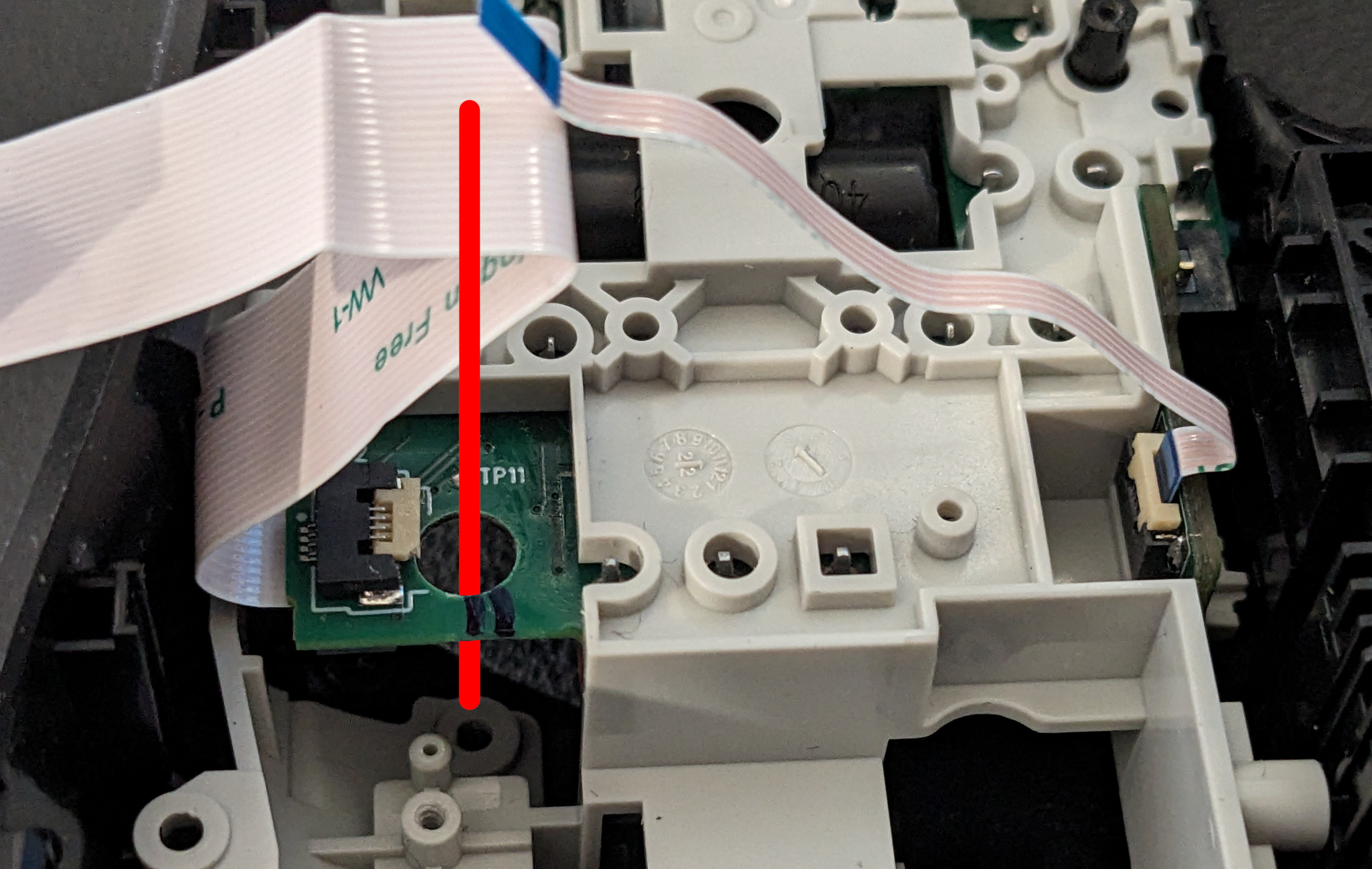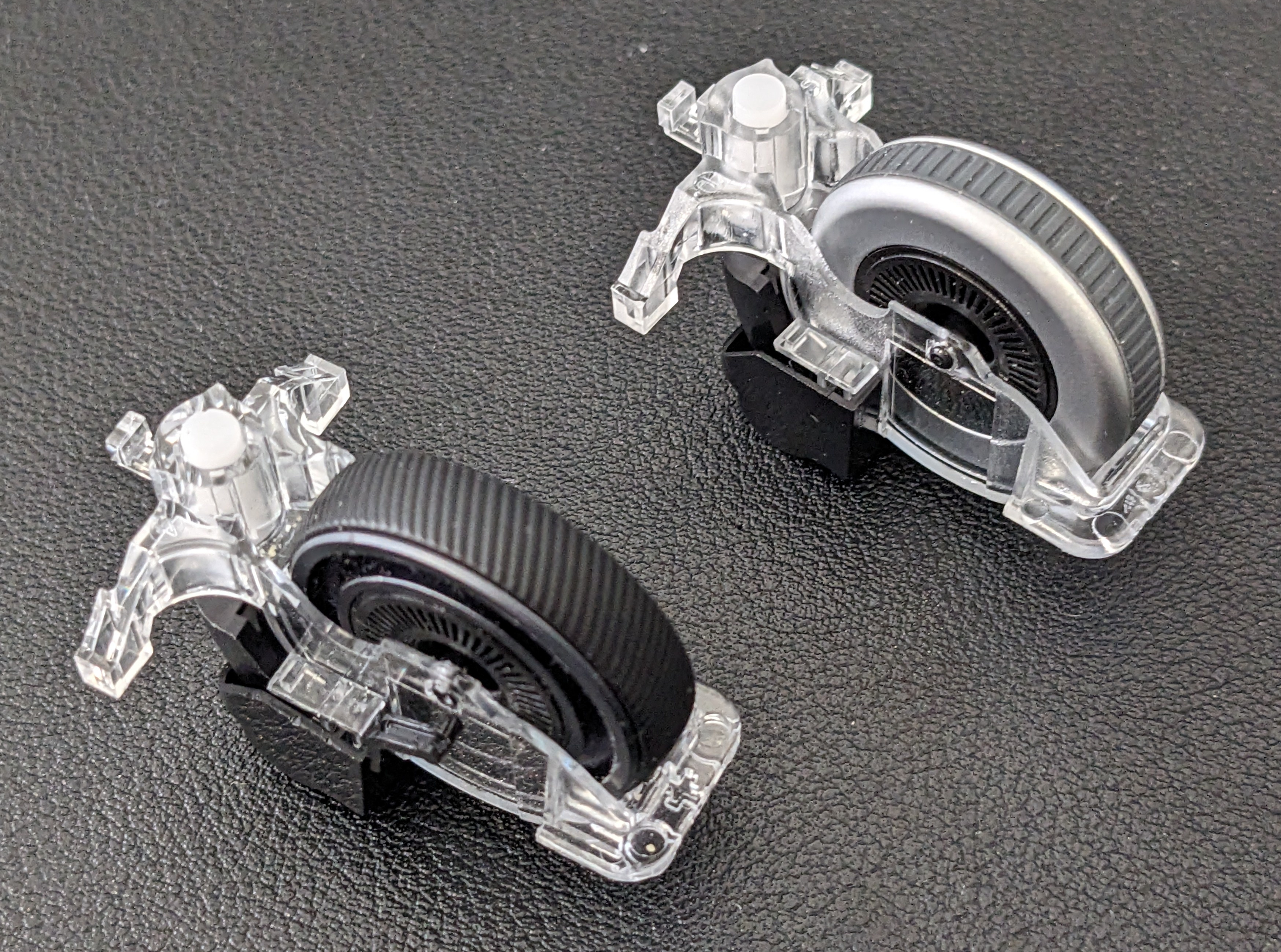There are two small springs under the scroll wheel assembly. Be careful to look for them when you remove it and do not let them jump out, or you risk losing them.
Now, with that off my chest, a bit of backtracking. The purpose of this post is to share a small bit of useful information that can be helpful when disassembling a G502 mouse, and doing that I take the occasion to share some thoughts about the device.
I usually dislike talking about (or even making passing mentions of) my hardware gear, which in my view boils down to free and uncalled-for advertisement. In this circumstance however I got inspired by technical aspects and I want to rather share a critical view of the device with the hope it can be useful to others.
Background
I have been using my G502 X Lightspeed for about two years and half, with moderate satisfaction. At the time I bought it I was completely renewing my home desk setup, and this model was the only mouse that, at the time, fulfilled all the requirements I had defined:1
- USB-C connector.
- Unlockable scroll wheel.
- Wireless, but with the option to work wired over USB cable.
- At least 7 buttons.
- Fully programmable with on-board memory.
- Bonus: No RGB.
Logitech using their own proprietary wireless charging protocol, as opposed to the more ubiquitous Qi standard, was concerning, but at the time I had not made my mind yet on the matter of wireless charging. On the other hand, I was intrigued by Logitech’s approach to wireless charging not requiring to park the mouse on a dedicated charging spot and allowing to charge even while using it,2 to the point that about one year later I decided to add a Powerplay mat to my setup. I ended up liking the benefits of wireless charging without having to even think about the battery at all.3
Two years and half later
I have been using the mouse for about two years and half, which I think makes it a much better point in time to share a critical review, compared to most “professional” reviews written after just a few days (if not hours) of usage.
I have mixed feelings about the device, but I think my view is more positive than negative.
The G502 X is a very lightweight mouse, so not for everyone’s taste. I am not a hardcore gamer and I do not care about gaming “performance”, which is one of the loudest drums being beaten in the advertisement of high-end desktop peripherals. However, using a lighter mouse is beneficial for ergonomic reasons, which is an important aspect to keep in mind when your whole work time (and a non-negligible amount of your off-work hours) revolve around your desk.4
When first trying the device, its lightness gave it almost a cheap feeling, contrasting to the good-looking quality of the build, but that went away fast as I got used to it.
The switches are also very light. I was worried about the bad reputation of previous G502 models’ switches, but apparently the G502 X uses different parts and thankfully I have not had any issues with them so far.
The original scroll wheel felt lightweighted but with a firm brake (if you have never used an unlockable scroll wheel I highly recommend giving it a try), but its durability has obviously been disappointing, breaking after only two years and half of usage.5 Even after taking it apart I am still not completely sure what exactly broke, technically the wheel was still functional (including the unlocking function) but it suddenly became very hard to turn, regardless of whether it was locked or unlocked.6
What about left-handed users?
I use the mouse with both hands, but primarily with my left hand (despite of being right-handed), so left-hand usability is usually an important factor when choosing a mouse.
 Left side of the device, with the G4 and G5 buttons visible, and the
plastic cover in place of where the G6 button should be.
Left side of the device, with the G4 and G5 buttons visible, and the
plastic cover in place of where the G6 button should be.
I would say the G502 X is usable with my left hand, though it is surely not the most left-hand friendly model I have had. The G4 and G5 side buttons are usable with my ring finger, though not as conveniently as other mice due to the top surface and the G7 and G8 buttons protruding to the left. The G6 button was too inconvenient and would end up being clicked by accident too often to be useful. Thankfully it is a removable button, held in place by a magnet, and so I quickly decided to uninstall it and put the provided cover piece in its place.
The G7 and G8 buttons feel also easy to accidentally click with my left middle finger, but not as much as the G6 button.
Internal design
When taking the mouse apart to reach the scroll wheel I was a bit surprised by its internal complexity. Clearly a lot of engineering design went into it.
The device has three PCBs and so many screws that it took over half an hour to take it apart. Surely it has come a long way since all you needed to fully take apart a (rolling-ball) mouse was to remove three or four screws on the bottom, and that was it.
 That is a lot of parts.
That is a lot of parts.
The battery is easy to replace, only needing to open the bottom. I only wish the bottom screws were not hidden under the pads, as it requires to remove the latter and risk damaging them in the process. In my case I managed to do that without causing too much wear on them, but this is a good example of putting aesthetics over functionality, especially considering the bottom of the mouse is already out of sight during normal use, so having a few visible screws on the bottom is far from being a real aesthetic problem to begin with.
Reaching the scroll wheel, on the other hand, requires to remove the middle panel and disassemble the buttons.
 Can you count how many screws are there?
Can you count how many screws are there?
Sometimes the disassembly shows how the design has been pushed and optimized, for instance one of the screws needs to be reached through a hole on the top PCB, and only after removing an FFC (flexible flat cable) from its socket. Getting to it requires a long and thin screwdriver, and only one of the screwdrivers in my set made it (barely).
 Reaching this one screw takes some effort.
Reaching this one screw takes some effort.
After taking out the top of the case and taking apart the middle panel to reach the upper PCB, it is finally possible to remove the scroll wheel assembly. That is when we reach the tricky part that inspired me to write this post, as there are two small springs balancing the scroll wheel assembly above the middle-button switch. Those two springs are neither glued nor fixed to the frame in any way, and they will jump out when uninstalling the scroll wheel assembly. I was not aware of it and I almost lost one of them, but thankfully it did not fall off my desk and I was able to find it after some search effort.
 The two springs balancing the middle button click.
The two springs balancing the middle button click.
Scroll wheel replacement
Thankfully, replacement parts are easy to find and not too outrageously expensive.7
 Original scroll wheel assembly (left) and replacement part (right).
Original scroll wheel assembly (left) and replacement part (right).
The first and most noticeable difference between original and replacement is its weight. The replacement part is significantly heavier, highlighting how much effort has been put into minimizing the weight of the G502 X, with its lightness being one of the main advertisement points over its predecessor G502.
I personally do not mind a few grams difference, and if anything I like the extra momentum from the additional weight on the wheel itself, especially when scrolling in unlocked mode. If the weight bothered me, I could try installing the old wheel in the new assembly8 and see if that still fixes the problem while retaining the lighter weight, but for now I am not concerned enough to even consider the option.
A second noticeable difference is how the wheel brake is lighter on the new wheel, giving it a longer stopping time when the wheel is in locked mode.9 This contrasts with how the original wheel would immediately stop upon lifting the finger while scrolling in locked mode. I am pretty sure this could also be changed by tweaking (or replacing) the spring controlling the brake, but I personally do not mind the difference for now.
Some inspiration
This little adventure had the side effect of making me reflect about ergonomics of the scroll wheel. Especially noticing how tiresome for the finger it was to turn the faulty wheel10 and afterwards thinking about the length and depth of the flexing movement required to operate a scroll wheel, even when the wheel itself rolls as smoothly as it gets.
When it comes to ergonomics, it is important to both minimize movement and minimize the amount of force needed in each movement, to reduce strain on both muscles and joints that can have negative effects in the long run.
All of this made me consider the idea of mapping the G7 and G8 buttons to scroll up and down and use them in place of the scroll wheel, as they require so much less effort to operate. Or possibly to remap the left and right tilt on the scroll wheel to instead scroll up and down. Or a combination of both (maybe for fast and slow scroll respectively).
I am not sure how discrete clicks or click-and-hold will feel when compared to the continuous motion of a wheel, but it will be interesting to see how easy or hard it is to adapt to it and how effective it will feel.
Footnotes
-
Surprisingly enough, the first requirement of having USB-C connector was unexpectedly hard to fulfill at the time, a surprising number of high-end models were still using USB Micro-B. ↩
-
On the flip side, the charging mat is more expensive than a Qi charger and not interoperable with other brands, implying a certain level of commitment to the brand and customer lock-in, of which I am not a fan. ↩
-
I do not want to use one-use replaceable batteries due to their environmental unfriendliness, even after ignoring the cost and the annoyance of keeping them in stock at home and replacing them when needed.
On top of that, I do not want to be bothered by having to keep an eye on the charge level of rechargeable batteries and have to charge them. Qi wireless charging pads make the process simpler (for models that support it), but they still require some active awareness from the user.
An extra benefit of this charging method is that the battery can be charged while in use, which should hopefully help when the battery ages. And the possibility of using the mouse over a USB cable acts as a final fallback, even if the internal battery where to die and I could not find a replacement part. ↩
-
To be fair, I use the mouse relatively little as most of my interaction with computers goes through the keyboard, but when it comes to health I will take all the help I can. ↩
-
So not long after expiration of the two-year legal warranty. ↩
-
I am sure it is not a matter of friction on the axle, and that nothing got stuck in between the wheel and its housing. ↩
-
Still more expensive than I would think, but at least not bad when compared to the price of the mouse itself. ↩
-
As I suspect the problem is likely with the assembly case rather than with the wheel itself. ↩
-
I assume this is also due to the additional weight on the replacement wheel, requiring more force to halt it. ↩
-
To the point that I had to put aside my G502 X and use an old spare mouse until the issue was fixed. Thankfully the replacement part was delivered in just one week. ↩